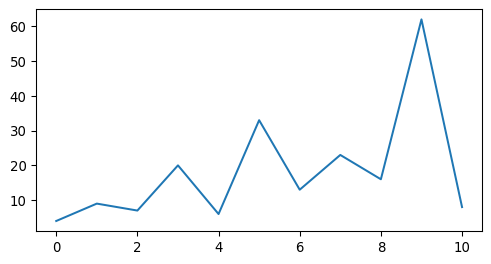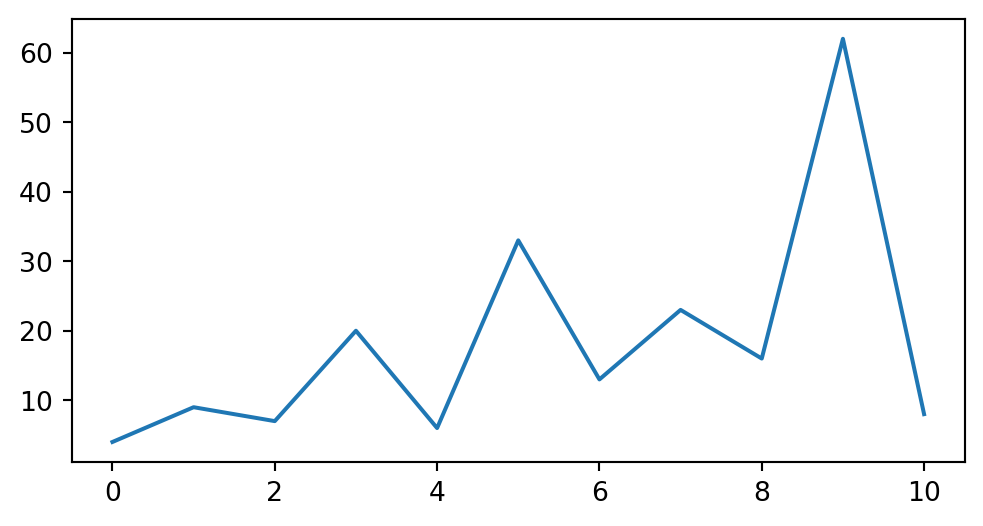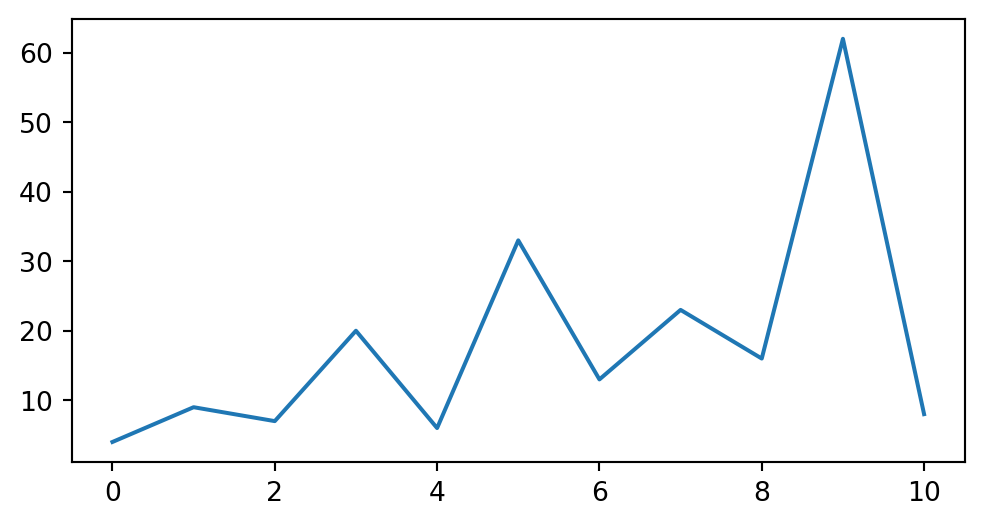Code Cells¶
Code, Output, Streams¶
An empty code cell:
[ ]:
Two empty lines:
[ ]:
Leading/trailing empty lines:
[1]:
# 2 empty lines before, 1 after
A simple output:
[2]:
6 * 7
[2]:
42
The standard output stream:
[3]:
print('Hello, world!')
Hello, world!
Normal output + standard output
[4]:
print('Hello, world!')
6 * 7
Hello, world!
[4]:
42
The standard error stream is highlighted and displayed just below the code cell. The standard output stream comes afterwards (with no special highlighting). Finally, the “normal” output is displayed.
[5]:
import sys
print("I'll appear on the standard error stream", file=sys.stderr)
print("I'll appear on the standard output stream")
"I'm the 'normal' output"
I'll appear on the standard output stream
I'll appear on the standard error stream
[5]:
"I'm the 'normal' output"
Note
Using the IPython kernel, the order is actually mixed up, see https://github.com/ipython/ipykernel/issues/280.
Special Display Formats¶
Local Image Files¶
[6]:
from IPython.display import Image
i = Image(filename='images/notebook_icon.png')
i
[6]:

[7]:
display(i)

See also SVG support for LaTeX.
[8]:
from IPython.display import SVG
SVG(filename='images/python_logo.svg')
[8]:
Image URLs¶
[9]:
Image(url='https://www.python.org/static/img/python-logo-large.png')
[9]:

[10]:
Image(url='https://www.python.org/static/img/python-logo-large.png', embed=True)
---------------------------------------------------------------------------
gaierror Traceback (most recent call last)
File /usr/lib/python3.12/urllib/request.py:1344, in AbstractHTTPHandler.do_open(self, http_class, req, **http_conn_args)
1343 try:
-> 1344 h.request(req.get_method(), req.selector, req.data, headers,
1345 encode_chunked=req.has_header('Transfer-encoding'))
1346 except OSError as err: # timeout error
File /usr/lib/python3.12/http/client.py:1336, in HTTPConnection.request(self, method, url, body, headers, encode_chunked)
1335 """Send a complete request to the server."""
-> 1336 self._send_request(method, url, body, headers, encode_chunked)
File /usr/lib/python3.12/http/client.py:1382, in HTTPConnection._send_request(self, method, url, body, headers, encode_chunked)
1381 body = _encode(body, 'body')
-> 1382 self.endheaders(body, encode_chunked=encode_chunked)
File /usr/lib/python3.12/http/client.py:1331, in HTTPConnection.endheaders(self, message_body, encode_chunked)
1330 raise CannotSendHeader()
-> 1331 self._send_output(message_body, encode_chunked=encode_chunked)
File /usr/lib/python3.12/http/client.py:1091, in HTTPConnection._send_output(self, message_body, encode_chunked)
1090 del self._buffer[:]
-> 1091 self.send(msg)
1093 if message_body is not None:
1094
1095 # create a consistent interface to message_body
File /usr/lib/python3.12/http/client.py:1035, in HTTPConnection.send(self, data)
1034 if self.auto_open:
-> 1035 self.connect()
1036 else:
File /usr/lib/python3.12/http/client.py:1470, in HTTPSConnection.connect(self)
1468 "Connect to a host on a given (SSL) port."
-> 1470 super().connect()
1472 if self._tunnel_host:
File /usr/lib/python3.12/http/client.py:1001, in HTTPConnection.connect(self)
1000 sys.audit("http.client.connect", self, self.host, self.port)
-> 1001 self.sock = self._create_connection(
1002 (self.host,self.port), self.timeout, self.source_address)
1003 # Might fail in OSs that don't implement TCP_NODELAY
File /usr/lib/python3.12/socket.py:841, in create_connection(address, timeout, source_address, all_errors)
840 exceptions = []
--> 841 for res in getaddrinfo(host, port, 0, SOCK_STREAM):
842 af, socktype, proto, canonname, sa = res
File /usr/lib/python3.12/socket.py:976, in getaddrinfo(host, port, family, type, proto, flags)
975 addrlist = []
--> 976 for res in _socket.getaddrinfo(host, port, family, type, proto, flags):
977 af, socktype, proto, canonname, sa = res
gaierror: [Errno -3] Temporary failure in name resolution
During handling of the above exception, another exception occurred:
URLError Traceback (most recent call last)
Cell In[10], line 1
----> 1 Image(url='https://www.python.org/static/img/python-logo-large.png', embed=True)
File /usr/lib/python3/dist-packages/IPython/core/display.py:1050, in Image.__init__(self, data, url, filename, format, embed, width, height, retina, unconfined, metadata, alt)
1048 self.unconfined = unconfined
1049 self.alt = alt
-> 1050 super(Image, self).__init__(data=data, url=url, filename=filename,
1051 metadata=metadata)
1053 if self.width is None and self.metadata.get('width', {}):
1054 self.width = metadata['width']
File /usr/lib/python3/dist-packages/IPython/core/display.py:370, in DisplayObject.__init__(self, data, url, filename, metadata)
367 elif self.metadata is None:
368 self.metadata = {}
--> 370 self.reload()
371 self._check_data()
File /usr/lib/python3/dist-packages/IPython/core/display.py:1085, in Image.reload(self)
1083 """Reload the raw data from file or URL."""
1084 if self.embed:
-> 1085 super(Image,self).reload()
1086 if self.retina:
1087 self._retina_shape()
File /usr/lib/python3/dist-packages/IPython/core/display.py:401, in DisplayObject.reload(self)
398 elif self.url is not None:
399 # Deferred import
400 from urllib.request import urlopen
--> 401 response = urlopen(self.url)
402 data = response.read()
403 # extract encoding from header, if there is one:
File /usr/lib/python3.12/urllib/request.py:215, in urlopen(url, data, timeout, cafile, capath, cadefault, context)
213 else:
214 opener = _opener
--> 215 return opener.open(url, data, timeout)
File /usr/lib/python3.12/urllib/request.py:515, in OpenerDirector.open(self, fullurl, data, timeout)
512 req = meth(req)
514 sys.audit('urllib.Request', req.full_url, req.data, req.headers, req.get_method())
--> 515 response = self._open(req, data)
517 # post-process response
518 meth_name = protocol+"_response"
File /usr/lib/python3.12/urllib/request.py:532, in OpenerDirector._open(self, req, data)
529 return result
531 protocol = req.type
--> 532 result = self._call_chain(self.handle_open, protocol, protocol +
533 '_open', req)
534 if result:
535 return result
File /usr/lib/python3.12/urllib/request.py:492, in OpenerDirector._call_chain(self, chain, kind, meth_name, *args)
490 for handler in handlers:
491 func = getattr(handler, meth_name)
--> 492 result = func(*args)
493 if result is not None:
494 return result
File /usr/lib/python3.12/urllib/request.py:1392, in HTTPSHandler.https_open(self, req)
1391 def https_open(self, req):
-> 1392 return self.do_open(http.client.HTTPSConnection, req,
1393 context=self._context)
File /usr/lib/python3.12/urllib/request.py:1347, in AbstractHTTPHandler.do_open(self, http_class, req, **http_conn_args)
1344 h.request(req.get_method(), req.selector, req.data, headers,
1345 encode_chunked=req.has_header('Transfer-encoding'))
1346 except OSError as err: # timeout error
-> 1347 raise URLError(err)
1348 r = h.getresponse()
1349 except:
URLError: <urlopen error [Errno -3] Temporary failure in name resolution>
[11]:
Image(url='https://jupyter.org/assets/homepage/main-logo.svg')
[11]:
Math¶
[12]:
from IPython.display import Math
eq = Math(r'\int\limits_{-\infty}^\infty f(x) \delta(x - x_0) dx = f(x_0)')
eq
[12]:
[13]:
display(eq)
[14]:
from IPython.display import Latex
Latex(r'This is a \LaTeX{} equation: $a^2 + b^2 = c^2$')
[14]:
[15]:
%%latex
\begin{equation}
\int\limits_{-\infty}^\infty f(x) \delta(x - x_0) dx = f(x_0)
\end{equation}
Plots¶
Make sure to use at least version 0.1.6 of the matplotlib-inline package (which is an automatic dependency of the ipython package).
By default, the plots created with the “inline” backend have the wrong size. More specifically, PNG plots (the default) will be slightly larger than SVG and PDF plots.
This can be fixed easily by creating a file named matplotlibrc (in the directory where your Jupyter notebooks live, e.g. in this directory: matplotlibrc) and adding the following line:
figure.dpi: 96
If you are using Git to manage your files, don’t forget to commit this local configuration file to your repository. Different directories can have different local configurations. If a given configuration should apply to multiple directories, symbolic links can be created in each directory.
For more details, see Default Values for Matplotlib’s “inline” Backend.
By default, plots are generated in the PNG format. In most cases, it looks better if SVG plots are used for HTML output and PDF plots are used for LaTeX/PDF. This can be achieved by setting nbsphinx_execute_arguments in your conf.py file like this:
nbsphinx_execute_arguments = [
"--InlineBackend.figure_formats={'svg', 'pdf'}",
]
In the following example, nbsphinx should use an SVG image in the HTML output and a PDF image for LaTeX/PDF output (other Jupyter clients like JupyterLab will still show the default PNG format).
[16]:
import matplotlib.pyplot as plt
[17]:
fig, ax = plt.subplots(figsize=[6, 3])
ax.plot([4, 9, 7, 20, 6, 33, 13, 23, 16, 62, 8]);
For comparison, this is how it would look in PNG format …
[18]:
%config InlineBackend.figure_formats = ['png']
[19]:
fig
[19]:

… and in 'png2x' (a.k.a. 'retina') format:
[20]:
%config InlineBackend.figure_formats = ['png2x']
[21]:
fig
[21]:

Instead of the default inline plotting backend, you can also use the widget backend (which needs the ipympl package to be installed):
[22]:
%matplotlib widget
---------------------------------------------------------------------------
ModuleNotFoundError Traceback (most recent call last)
Cell In[22], line 1
----> 1 get_ipython().run_line_magic('matplotlib', 'widget')
File /usr/lib/python3/dist-packages/IPython/core/interactiveshell.py:2480, in InteractiveShell.run_line_magic(self, magic_name, line, _stack_depth)
2478 kwargs['local_ns'] = self.get_local_scope(stack_depth)
2479 with self.builtin_trap:
-> 2480 result = fn(*args, **kwargs)
2482 # The code below prevents the output from being displayed
2483 # when using magics with decorator @output_can_be_silenced
2484 # when the last Python token in the expression is a ';'.
2485 if getattr(fn, magic.MAGIC_OUTPUT_CAN_BE_SILENCED, False):
File /usr/lib/python3/dist-packages/IPython/core/magics/pylab.py:103, in PylabMagics.matplotlib(self, line)
98 print(
99 "Available matplotlib backends: %s"
100 % _list_matplotlib_backends_and_gui_loops()
101 )
102 else:
--> 103 gui, backend = self.shell.enable_matplotlib(args.gui)
104 self._show_matplotlib_backend(args.gui, backend)
File /usr/lib/python3/dist-packages/IPython/core/interactiveshell.py:3677, in InteractiveShell.enable_matplotlib(self, gui)
3673 print('Warning: Cannot change to a different GUI toolkit: %s.'
3674 ' Using %s instead.' % (gui, self.pylab_gui_select))
3675 gui, backend = pt.find_gui_and_backend(self.pylab_gui_select)
-> 3677 pt.activate_matplotlib(backend)
3679 from matplotlib_inline.backend_inline import configure_inline_support
3681 configure_inline_support(self, backend)
File /usr/lib/python3/dist-packages/IPython/core/pylabtools.py:410, in activate_matplotlib(backend)
405 # Due to circular imports, pyplot may be only partially initialised
406 # when this function runs.
407 # So avoid needing matplotlib attribute-lookup to access pyplot.
408 from matplotlib import pyplot as plt
--> 410 plt.switch_backend(backend)
412 plt.show._needmain = False
413 # We need to detect at runtime whether show() is called by the user.
414 # For this, we wrap it into a decorator which adds a 'called' flag.
File /usr/lib/python3/dist-packages/matplotlib/pyplot.py:342, in switch_backend(newbackend)
339 # have to escape the switch on access logic
340 old_backend = dict.__getitem__(rcParams, 'backend')
--> 342 module = importlib.import_module(cbook._backend_module_name(newbackend))
343 canvas_class = module.FigureCanvas
345 required_framework = canvas_class.required_interactive_framework
File /usr/lib/python3.12/importlib/__init__.py:90, in import_module(name, package)
88 break
89 level += 1
---> 90 return _bootstrap._gcd_import(name[level:], package, level)
File <frozen importlib._bootstrap>:1387, in _gcd_import(name, package, level)
File <frozen importlib._bootstrap>:1360, in _find_and_load(name, import_)
File <frozen importlib._bootstrap>:1310, in _find_and_load_unlocked(name, import_)
File <frozen importlib._bootstrap>:488, in _call_with_frames_removed(f, *args, **kwds)
File <frozen importlib._bootstrap>:1387, in _gcd_import(name, package, level)
File <frozen importlib._bootstrap>:1360, in _find_and_load(name, import_)
File <frozen importlib._bootstrap>:1324, in _find_and_load_unlocked(name, import_)
ModuleNotFoundError: No module named 'ipympl'
[23]:
fig, ax = plt.subplots(figsize=[6, 3])
ax.plot([4, 9, 7, 20, 6, 33, 13, 23, 16, 62, 8]);

Pandas Dataframes¶
Pandas dataframes should be displayed as nicely formatted HTML tables (if you are using HTML output).
[24]:
import numpy as np
import pandas as pd
[25]:
np.random.seed(0)
df = pd.DataFrame(np.random.randint(0, 100, size=[10, 4]),
columns=[r'$\alpha$', r'$\beta$', r'$\gamma$', r'$\delta$'])
df
[25]:
| $\alpha$ | $\beta$ | $\gamma$ | $\delta$ | |
|---|---|---|---|---|
| 0 | 44 | 47 | 64 | 67 |
| 1 | 67 | 9 | 83 | 21 |
| 2 | 36 | 87 | 70 | 88 |
| 3 | 88 | 12 | 58 | 65 |
| 4 | 39 | 87 | 46 | 88 |
| 5 | 81 | 37 | 25 | 77 |
| 6 | 72 | 9 | 20 | 80 |
| 7 | 69 | 79 | 47 | 64 |
| 8 | 82 | 99 | 88 | 49 |
| 9 | 29 | 19 | 19 | 14 |
Markdown Content¶
[26]:
from IPython.display import Markdown
[27]:
md = Markdown("""
# Markdown
It *should* show up as **formatted** text
with things like [links] and images.
[links]: https://jupyter.org/

## Markdown Extensions
There might also be mathematical equations like
$a^2 + b^2 = c^2$
and even tables:
A | B | A and B
------|-------|--------
False | False | False
True | False | False
False | True | False
True | True | True
""")
md
YouTube Videos¶
[28]:
from IPython.display import YouTubeVideo
YouTubeVideo('9_OIs49m56E')
[28]:
Interactive Widgets (HTML only)¶
The basic widget infrastructure is provided by the ipywidgets module. More advanced widgets are available in separate packages, see for example https://jupyter.org/widgets.
The JavaScript code which is needed to display Jupyter widgets is loaded automatically (using RequireJS). If you want to use non-default URLs or local files, you can use the nbsphinx_widgets_path and nbsphinx_requirejs_path settings.
Other Languages
The examples shown here are using Python, but the widget technology can also be used with different Jupyter kernels (i.e. with different programming languages).
Troubleshooting¶
To obtain more information if widgets are not displayed as expected, you will need to look at the error message in the web browser console.
To figure out how to open the web browser console, you may look at the web browser documentation:
The error is most probably linked to the JavaScript files not being loaded or loaded in the wrong order within the HTML file. To analyze the error, you can inspect the HTML file within the web browser (e.g.: right-click on the page and select View Page Source) and look at the <head> section of the page. That section should contain some JavaScript libraries. Those relevant for widgets are:
<!-- require.js is a mandatory dependency for jupyter-widgets -->
<script crossorigin="anonymous" integrity="sha256-Ae2Vz/4ePdIu6ZyI/5ZGsYnb+m0JlOmKPjt6XZ9JJkA=" src="https://cdnjs.cloudflare.com/ajax/libs/require.js/2.3.4/require.min.js"></script>
<!-- jupyter-widgets JavaScript -->
<script type="text/javascript" src="https://unpkg.com/@jupyter-widgets/html-manager@^0.18.0/dist/embed-amd.js"></script>
<!-- JavaScript containing custom Jupyter widgets -->
<script src="../_static/embed-widgets.js"></script>
The two first elements are mandatory. The third one is required only if you designed your own widgets but did not publish them on npm.js.
If those libraries appear in a different order, the widgets won’t be displayed.
Here is a list of possible solutions:
Arbitrary JavaScript Output (HTML only)¶
[29]:
%%javascript
var text = document.createTextNode("Hello, I was generated with JavaScript!");
// Content appended to "element" will be visible in the output area:
element.appendChild(text);
Unsupported Output Types¶
If a code cell produces data with an unsupported MIME type, the Jupyter Notebook doesn’t generate any output. nbsphinx, however, shows a warning message.
[30]:
display({
'text/x-python': 'print("Hello, world!")',
'text/x-haskell': 'main = putStrLn "Hello, world!"',
}, raw=True)
Data type cannot be displayed: text/x-python, text/x-haskell
ANSI Colors¶
The standard output and standard error streams may contain ANSI escape sequences to change the text and background colors.
[31]:
print('BEWARE: \x1b[1;33;41mugly colors\x1b[m!', file=sys.stderr)
print('AB\x1b[43mCD\x1b[35mEF\x1b[1mGH\x1b[4mIJ\x1b[7m'
'KL\x1b[49mMN\x1b[39mOP\x1b[22mQR\x1b[24mST\x1b[27mUV')
ABCDEFGHIJKLMNOPQRSTUV
BEWARE: ugly colors!
The following code showing the 8 basic ANSI colors is based on https://web.archive.org/web/20231225185739/https://tldp.org/HOWTO/Bash-Prompt-HOWTO/x329.html. Each of the 8 colors has an “intense” variation, which is used for bold text.
[32]:
text = ' XYZ '
formatstring = '\x1b[{}m' + text + '\x1b[m'
print(' ' * 6 + ' ' * len(text) +
''.join('{:^{}}'.format(bg, len(text)) for bg in range(40, 48)))
for fg in range(30, 38):
for bold in False, True:
fg_code = ('1;' if bold else '') + str(fg)
print(' {:>4} '.format(fg_code) + formatstring.format(fg_code) +
''.join(formatstring.format(fg_code + ';' + str(bg))
for bg in range(40, 48)))
40 41 42 43 44 45 46 47
30 XYZ XYZ XYZ XYZ XYZ XYZ XYZ XYZ XYZ
1;30 XYZ XYZ XYZ XYZ XYZ XYZ XYZ XYZ XYZ
31 XYZ XYZ XYZ XYZ XYZ XYZ XYZ XYZ XYZ
1;31 XYZ XYZ XYZ XYZ XYZ XYZ XYZ XYZ XYZ
32 XYZ XYZ XYZ XYZ XYZ XYZ XYZ XYZ XYZ
1;32 XYZ XYZ XYZ XYZ XYZ XYZ XYZ XYZ XYZ
33 XYZ XYZ XYZ XYZ XYZ XYZ XYZ XYZ XYZ
1;33 XYZ XYZ XYZ XYZ XYZ XYZ XYZ XYZ XYZ
34 XYZ XYZ XYZ XYZ XYZ XYZ XYZ XYZ XYZ
1;34 XYZ XYZ XYZ XYZ XYZ XYZ XYZ XYZ XYZ
35 XYZ XYZ XYZ XYZ XYZ XYZ XYZ XYZ XYZ
1;35 XYZ XYZ XYZ XYZ XYZ XYZ XYZ XYZ XYZ
36 XYZ XYZ XYZ XYZ XYZ XYZ XYZ XYZ XYZ
1;36 XYZ XYZ XYZ XYZ XYZ XYZ XYZ XYZ XYZ
37 XYZ XYZ XYZ XYZ XYZ XYZ XYZ XYZ XYZ
1;37 XYZ XYZ XYZ XYZ XYZ XYZ XYZ XYZ XYZ
ANSI also supports a set of 256 indexed colors. The following code showing all of them is based on http://bitmote.com/index.php?post/2012/11/19/Using-ANSI-Color-Codes-to-Colorize-Your-Bash-Prompt-on-Linux.
[33]:
formatstring = '\x1b[38;5;{0};48;5;{0}mX\x1b[1mX\x1b[m'
print(' + ' + ''.join('{:2}'.format(i) for i in range(36)))
print(' 0 ' + ''.join(formatstring.format(i) for i in range(16)))
for i in range(7):
i = i * 36 + 16
print('{:3} '.format(i) + ''.join(formatstring.format(i + j)
for j in range(36) if i + j < 256))
+ 0 1 2 3 4 5 6 7 8 91011121314151617181920212223242526272829303132333435
0 XXXXXXXXXXXXXXXXXXXXXXXXXXXXXXXX
16 XXXXXXXXXXXXXXXXXXXXXXXXXXXXXXXXXXXXXXXXXXXXXXXXXXXXXXXXXXXXXXXXXXXXXXXX
52 XXXXXXXXXXXXXXXXXXXXXXXXXXXXXXXXXXXXXXXXXXXXXXXXXXXXXXXXXXXXXXXXXXXXXXXX
88 XXXXXXXXXXXXXXXXXXXXXXXXXXXXXXXXXXXXXXXXXXXXXXXXXXXXXXXXXXXXXXXXXXXXXXXX
124 XXXXXXXXXXXXXXXXXXXXXXXXXXXXXXXXXXXXXXXXXXXXXXXXXXXXXXXXXXXXXXXXXXXXXXXX
160 XXXXXXXXXXXXXXXXXXXXXXXXXXXXXXXXXXXXXXXXXXXXXXXXXXXXXXXXXXXXXXXXXXXXXXXX
196 XXXXXXXXXXXXXXXXXXXXXXXXXXXXXXXXXXXXXXXXXXXXXXXXXXXXXXXXXXXXXXXXXXXXXXXX
232 XXXXXXXXXXXXXXXXXXXXXXXXXXXXXXXXXXXXXXXXXXXXXXXX
You can even use 24-bit RGB colors:
[34]:
start = 255, 0, 0
end = 0, 0, 255
length = 79
out = []
for i in range(length):
rgb = [start[c] + int(i * (end[c] - start[c]) / length) for c in range(3)]
out.append('\x1b['
'38;2;{rgb[2]};{rgb[1]};{rgb[0]};'
'48;2;{rgb[0]};{rgb[1]};{rgb[2]}mX\x1b[m'.format(rgb=rgb))
print(''.join(out))
XXXXXXXXXXXXXXXXXXXXXXXXXXXXXXXXXXXXXXXXXXXXXXXXXXXXXXXXXXXXXXXXXXXXXXXXXXXXXXX